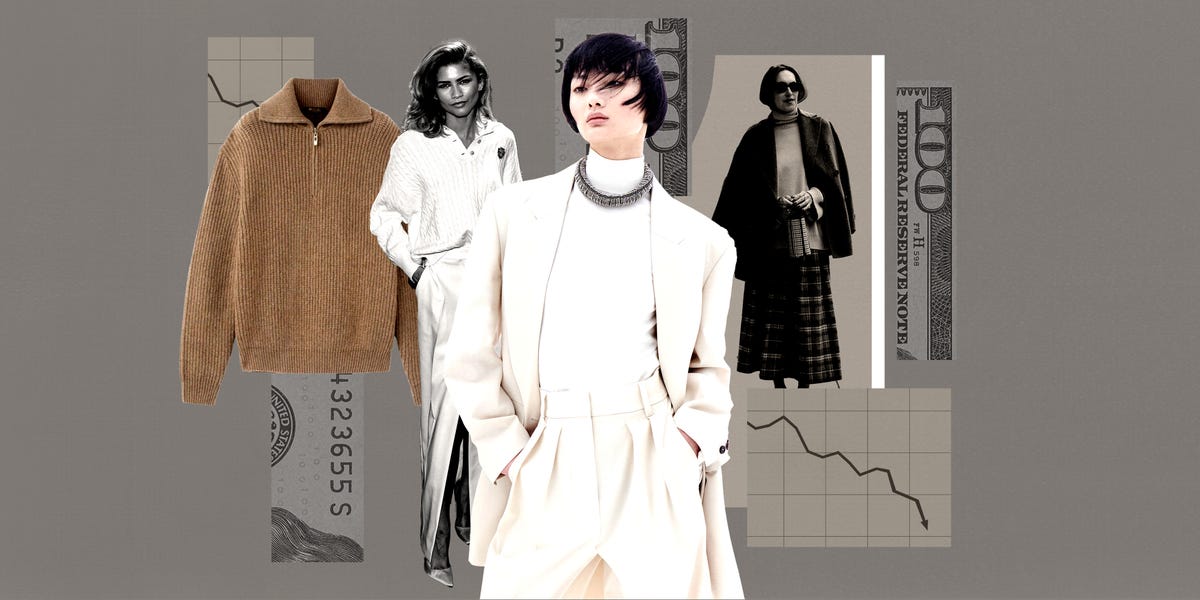
Try our newest merchandise
Prepare to return to fundamentals.
With the chances of a recession rising, the style business will possible transfer with the financial winds. Pattern forecasters, style writers, and teachers advised Enterprise Insider that impartial tones, conservative silhouettes, and minimalism will in all probability dominate the runways and retail home windows if a dip occurs.
“Recessions are inclined to flatten aspiration,” Sarah Owen, a development forecaster and social scientist, advised BI in an announcement. “When the long run feels unsure, style tends to recoil into the acquainted.”
Recessions of the previous provide style clues
From the Thirties to 2008, historical past’s financial downturns trace on the developments to return.
“Previous recessions see style developments get quieter,” mentioned Monisha Klar, the director of style at development forecasting firm WGSN. They often result in an increase in blacks, whites, neutrals, and grays, mentioned Vincent Quan, a professor on the Style Institute of Expertise.
Throughout the Nice Despair, for instance, hemlines acquired longer, Owen mentioned. After the dot-com recession in 2001, she mentioned folks turned to secure Americana, whereas the Nice Recession lent itself to “‘recession-core minimalism.'”
“Entrenchment. Much less daring designs. Revivals of the previous versus some wild new factor,” Anne Higonnet, an artwork historical past professor at Barnard Faculty who teaches a course on clothes, mentioned when describing the developments of earlier recessions.
Stealth wealth is probably going right here to remain
Quiet luxurious has been on the rise for years, and the specialists BI spoke to mentioned it in all probability will not go wherever if a full-blown recession hits. They mentioned the uber-rich will possible proceed shopping for luxurious clothes since they are not as financially squeezed by financial downturns, however that the clothes will nonetheless mirror the nation’s temper.
“It was seen as poor style to indicate off your wealth as a result of so many individuals had misplaced a fortune,” Dana Thomas, writer of “Deluxe: How Luxurious Misplaced Its Luster,” mentioned of the post-2008 luxurious atmosphere.
Even when the nation’s wealthiest proceed to purchase understated items, there are indicators that luxurious homes will really feel a pinch. LVMH, which owns manufacturers together with Louis Vuitton and Dior, did not hit first-quarter gross sales estimates. Hermés introduced that it’ll increase costs within the US because it braces for the way tariffs may affect its development.
“Luxurious will not vanish, ever, it simply will get quieter,” Owen mentioned.
Alessandro Levati/Getty Photographs for Brunello Cucinelli
Folks will return to fundamentals
For consumers who aren’t spending hundreds of {dollars} on a shirt, a recession will nonetheless in all probability imply much less flashy clothes — and a concentrate on versatile objects.
“There will be a flight towards worth,” Quan, the FIT professor, mentioned. He thinks fundamentals that may be worn a number of instances will spike in reputation.
“You see an abrupt shift away from maximalist concepts, as customers search merchandise extra aligned with budgeting for on a regular basis life,” Klar from WGSN mentioned, predicting that office-inspired seems will stay fashionable.
Resale will possible thrive, three of the specialists mentioned, however middle-market, inexpensive luxurious firms will in all probability undergo. Derek Man, an internet-famous menswear author, mentioned these prospects may downgrade to quick style, however luxurious consumers will not downgrade from the highest.
“Mid-tier luxurious is at all times the primary to really feel the squeeze,” development forecaster Owen mentioned. “It is neither important nor status-y sufficient to justify the spend.”
Tariffs are scrambling the entire sector
President Donald Trump’s commerce struggle with China has explicit ramifications for the sector — the US imported $19.6 billion in textiles and clothes from the nation in 2023, based on Census Bureau information.
Higonnet mentioned that although some clothes manufacturing has moved from China to surrounding nations, like Vietnam and Cambodia, this could possibly be the “greatest blow” the quick style business has confronted.
Such firms are “not going to have the ability to simply construct factories within the US and preserve their costs,” she mentioned.
It isn’t simply quick style that may really feel the ache if Trump’s tariffs stay in place.
“One false impression that individuals have is that China simply makes a bunch of low cost crap and that we’ll see a shift towards higher-end clothes,” Man mentioned. Chinese language factories, he mentioned, manufacture every part from $5 Shein tops to $1,200 hand-knitted Double RL cashmere sweaters.
“They don’t seem to be utilizing a Chinese language manufacturing unit as a result of they’re shopping for a hand-knitted cardigan for $2. It is as a result of that particular place that they use makes the perfect cardigans in that model,” he mentioned.
Shoppers may see decrease high quality or a “skyrocketing of costs” if firms have to maneuver factories, based on Man.
With financial uncertainty seeming like the one certainty, every part from the most affordable polyester tops to probably the most luxurious cashmere blends will slink into their very own variations of style security.
As Thomas put it, “If this carries on like it’s, we’ll simply hold sporting beige.”





![[2024] MSI Aegis R2 C14NUF9-829US (Intel Core i9-14900F, 128GB DDR5 RAM, 2X 2TB NVMe SSD, NVIDIA GeForce RTX 4070 Ti Super, Windows 11) Gaming Desktop PC](https://m.media-amazon.com/images/I/81i1KVslX4L._AC_SL1500_.jpg)







